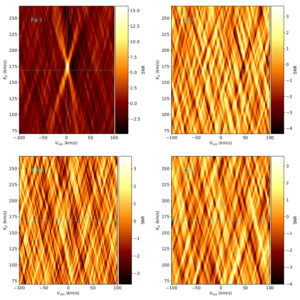PETS paper II: Thermal Inversion Agents in KELT-20 b/MASCARA-2 b

The second paper of the PEPSI Exoplanet Transit Survey (PETS) performs a search for possible atomic and molecular species that may drive the thermal inversion in the atmospheres of ultrahot Jupiters, and it rules out several species in the case of KELT-20 b/MASCARA-2 b:
Johnson, Marshall C.; Wang, Ji; Pai Asnodkar, Anusha; Bonomo, Aldo S.; Gaudi, B. Scott; Henning, Thomas; Ilyin, Ilya; Keles, Engin; Malavolta, Luca; Mallonn, Matthias; Molaverdikhani, Karan; Nascimbeni, Valerio; Patience, Jennifer; Poppenhaeger, Katja; Scandariato, Gaetano; Schlawin, Everett; Shkolnik, Evgenya; Sicilia, Daniela; Sozzetti, Alessandro; Strassmeier, Klaus G.; Veillet, Christian; Yan, Fe
Abstract: Recent observations have shown that the atmospheres of ultra hot Jupiters (UHJs) commonly possess temperature inversions, where the temperature increases with increasing altitude. Nonetheless, which opacity sources are responsible for the presence of these inversions remains largely observationally unconstrained. We used LBT/PEPSI to observe the atmosphere of the UHJ KELT-20 b in both transmission and emission in order to search for molecular agents which could be responsible for the temperature inversion. We validate our methodology by confirming a previous detection of Fe I in emission at 15.1σ; however, we are unable to reproduce published detections of Fe II, Cr I, or Si I. We attribute the non-detection of Si I to the lack of lines in our bandpass, but the non-detections of Fe II and Cr I are puzzling due to our much higher signal-to-noise ratio than previous works. Our search for the inversion agents TiO, VO, FeH, and CaH results in non-detections. Using injection-recovery testing we set 4σ upper limits upon the volume mixing ratios for these constituents as low as ∼1×10−10 for TiO. For TiO, VO, and CaH, our limits are much lower than expectations from an equilibrium chemical model, while FeH is lower than the expectations only from a super-Solar metallicity model. We thus rule out TiO, VO, and CaH as the source of the temperature inversion in KELT-20 b, while FeH is disfavored only if KELT-20 b possesses a high-metallicity atmosphere.
17 pages, 11 figures. Submitted to AAS Journals.